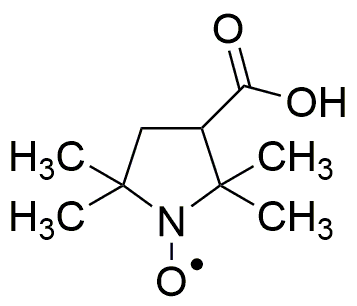3-Carboxy-PROXYL is widely utilized in research focused on:
- Biochemical Studies: This compound serves as a spin label in electron paramagnetic resonance (EPR) spectroscopy, allowing researchers to study molecular dynamics and interactions in biological systems.
- Antioxidant Research: Its ability to scavenge free radicals makes it valuable in studies investigating oxidative stress and the development of antioxidant therapies in various diseases.
- Drug Development: Used in the formulation of pharmaceuticals, it helps in understanding drug stability and interactions, enhancing the efficacy of new medications.
- Polymer Science: In the field of materials science, it is employed to investigate polymer structures and properties, aiding in the design of advanced materials with specific functionalities.
- Environmental Monitoring: This compound can be utilized to assess the oxidative status of environmental samples, contributing to studies on pollution and its effects on ecosystems.
Información general
Propiedades
Seguridad y normativas
Aplicaciones
3-Carboxy-PROXYL is widely utilized in research focused on:
- Biochemical Studies: This compound serves as a spin label in electron paramagnetic resonance (EPR) spectroscopy, allowing researchers to study molecular dynamics and interactions in biological systems.
- Antioxidant Research: Its ability to scavenge free radicals makes it valuable in studies investigating oxidative stress and the development of antioxidant therapies in various diseases.
- Drug Development: Used in the formulation of pharmaceuticals, it helps in understanding drug stability and interactions, enhancing the efficacy of new medications.
- Polymer Science: In the field of materials science, it is employed to investigate polymer structures and properties, aiding in the design of advanced materials with specific functionalities.
- Environmental Monitoring: This compound can be utilized to assess the oxidative status of environmental samples, contributing to studies on pollution and its effects on ecosystems.
Documentos
Hojas de datos de seguridad (HDS)
La SDS proporciona información de seguridad completa sobre la manipulación, el almacenamiento y la eliminación del producto.
Especificación del producto (PS)
La PS proporciona un desglose completo de las propiedades del producto, incluida la composición química, el estado físico, la pureza y los requisitos de almacenamiento. También detalla los rangos de calidad aceptables y las aplicaciones previstas del producto.
Certificados de análisis (COA)
Busque certificados de análisis (COA) ingresando el número de lote del producto. Los números de lote y de partida se pueden encontrar en la etiqueta de un producto después de las palabras "Lote" o "Lote".
Número de catálogo
Número de lote/lote
Certificados de origen (COO)
Este certificado de origen confirma el país en el que se fabricó el producto y también detalla los materiales y componentes utilizados en él y si se deriva de fuentes naturales, sintéticas u otras fuentes específicas. Este certificado puede ser necesario para cumplir con las normativas aduaneras, comerciales y regulatorias.
Número de catálogo
Número de lote/lote
Hojas de datos de seguridad (HDS)
La SDS proporciona información de seguridad completa sobre la manipulación, el almacenamiento y la eliminación del producto.
DownloadEspecificación del producto (PS)
La PS proporciona un desglose completo de las propiedades del producto, incluida la composición química, el estado físico, la pureza y los requisitos de almacenamiento. También detalla los rangos de calidad aceptables y las aplicaciones previstas del producto.
DownloadCertificados de análisis (COA)
Busque certificados de análisis (COA) ingresando el número de lote del producto. Los números de lote y de partida se pueden encontrar en la etiqueta de un producto después de las palabras "Lote" o "Lote".
Número de catálogo
Número de lote/lote
Certificados de origen (COO)
Este certificado de origen confirma el país en el que se fabricó el producto y también detalla los materiales y componentes utilizados en él y si se deriva de fuentes naturales, sintéticas u otras fuentes específicas. Este certificado puede ser necesario para cumplir con las normativas aduaneras, comerciales y regulatorias.


